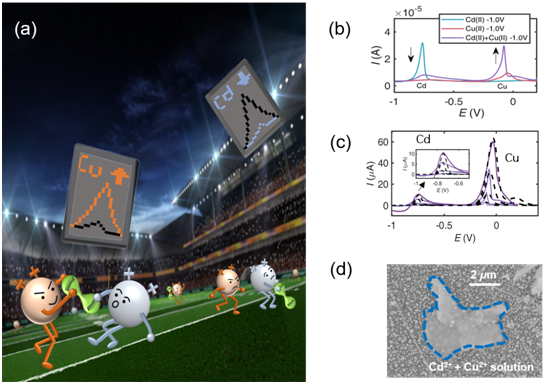Scientists from Institute of Intelligent Machines, Hefei Institutes of Physical Science, find a new interference mechanism in the simultaneous detection of heavy metal ions (HMIs) Cd(II) and Cu(II), providing new physical insights for the co-deposition of multiple HMIs andapplicable guidance for the design of detection electrode. This work was published in Analytical Chemistry.
Striping voltammetry is a rapid technique for detecting HMIs in the aqueous solution. However, in the solution containing more than one HMI analytes, the co-existed HMIs cause interference and the measurement accuracy cannot be guaranteed which prevents the development of HMI detection in the fields of both fundamental research and industrial application.
In this work, the interference between two example HMIs, Cd(II) and Cu(II), is explored. A kinetic model is built to describe the electroanalysis of HMI and the key parameters are measured from the experiment. By comparing the electrode kinetics of Cd and Cu in the individual detections and the simultaneous detections, it is found that the replacement of Cd by Cu(II) at the preconcentration stage is the main reason for the interference and selecting the electrode material of Cu-affinity may be helpful to avoid such interference. The interference between Cd and Cu is explained and the kinetic model can be applied to understand the electroanalysis for other HMIs.
This work was supported financially by the National Natural Science Foundation of China (21802145, 21735005), the Postdoctoral Innovation Talents Supporting Project (BX20180311), the Science and Technology Major Project of Anhui Province (17030801033), Key Program of 13th five-year plan, Hefei Institutes of Physical Science, Chinese Academy of Sciences (CAS). C.-H.L. acknowledges the One Hundred Person Project, and X.-J. H. thanks the CAS Interdisciplinary Innovation Team, Chinese Academy of Sciences, China, for financial support.
Article link: https://pubs.acs.org/doi/10.1021/acs.analchem.9b01724

Figure (a) Illustration of the manual interference of Cd(II) and Cu(II)in the co-deposition; (b) Stripping voltammograms measured in the individual Cd(II) solution (blue line), the individual Cu(II) solution (red line), and the mixed solution of Cd(II) and Cu(II) (purple line); (c) Experiment (solid lines) and simulation (dashed lines) of the stripping voltammograms in the mixed solution of Cd(II) and Cu(II) under various square wave frequency; (d)SEMimage of co-deposited Cd and Cu, where the blue line outlines a butterfly-shape Cd deposit.
(Image by LIN Chuhong)
